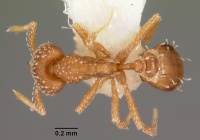Strumigenys omalyx
| Strumigenys omalyx | |
|---|---|

| |
| Scientific classification | |
| Kingdom: | Animalia |
| Phylum: | Arthropoda |
| Class: | Insecta |
| Order: | Hymenoptera |
| Family: | Formicidae |
| Subfamily: | Myrmicinae |
| Tribe: | Attini |
| Genus: | Strumigenys |
| Species: | S. omalyx |
| Binomial name | |
| Strumigenys omalyx Bolton, 1983 | |
One of the few specimens of this species was collected from a pitfall trap in primary forest.
Identification
A member of the arnoldi complex in the Strumigenys arnoldi-group.
Bolton (1983) - Closest related to Strumigenys arnoldi and sharing that species' lack of pronotal flagellate hairs whilst retaining a complete mandibular dentition of 2 preapical teeth on each blade. S. omalyx is separated from arnoldi by the presence in the former of sculptured pronotal sides and postpetiolar disc, and a lack of longitudinal rugulae on the pronotal dorsum. In arnoldi the pronotum is smooth laterally, the disc of the postpetiole is smooth and longitudinal rugulae are present on the pronotal dorsum.
Keys including this Species
Distribution
Latitudinal Distribution Pattern
Latitudinal Range: -3.916666667° to -5.57934°.
| North Temperate |
North Subtropical |
Tropical | South Subtropical |
South Temperate |
- Source: AntMaps
Distribution based on Regional Taxon Lists
Afrotropical Region: Kenya (type locality), United Republic of Tanzania.
Distribution based on AntMaps
Distribution based on AntWeb specimens
Check data from AntWeb
Countries Occupied
| Number of countries occupied by this species based on AntWiki Regional Taxon Lists. In general, fewer countries occupied indicates a narrower range, while more countries indicates a more widespread species. |

|
Estimated Abundance
| Relative abundance based on number of AntMaps records per species (this species within the purple bar). Fewer records (to the left) indicates a less abundant/encountered species while more records (to the right) indicates more abundant/encountered species. |

|
Biology
Castes
Nomenclature
The following information is derived from Barry Bolton's Online Catalogue of the Ants of the World.
- omalyx. Strumigenys omalyx Bolton, 1983: 382, fig. 63 (w.q.) KENYA. See also: Bolton, 2000: 595.
Unless otherwise noted the text for the remainder of this section is reported from the publication that includes the original description.
Description
Worker
Holotype. TL 2.3, HL 0.57, HW 0.45, CI 79, ML 0.23, MI 40, SL 0.31, SI 69, PW 0.26, AL 0.58.
Mandibles in full-face view of approximately the same width to the proximal preapical tooth, not evenly tapering from base to apex. Apical fork of 2 spiniform teeth on each mandible, without intercalary teeth or denticles. Each mandibular blade with 2 preapical teeth, the proximal much longer than the distal in each case. Upper scrobe margins with a narrow bordering rim or flange, the eyes not visible in full-face view. Eyes small, with only 5-6 ommatidia, the maximum diameter of the eye conspicuously much less than the maximum width of the scape. Preocular notch absent, the ventral surface of the head without a transverse pre ocular groove or impression. Antennal scapes shallowly bent at about the basal third, somewhat dorsoventrally flattened and broadest at about the midlength, their leading edges distinctly convex and equipped with a row of apically curved large spatulate to spoon-shaped hairs which are as large as or slightly larger than those fringing the upper scrobe margins. Dorsum of head in full-face view clothed with broad scale-like to stud-like hairs which do not decrease in size posteriorly on the dorsum. Cephalic dorsum with a transverse row of 4 stout standing hairs close to the occipital margin, without a more anteriorly situated pair close to the highest point of the vertex. Head densely and strongly reticulate-punctate everywhere. Pronotal humeri without flagellate hairs, lacking projecting hairs of any description. Mesonotum with a single pair of stout standing hairs which are broadly clavate apically. Ground-pilosity of dorsal alitrunk of sparse scattered scale-like hairs. Metanotal groove feebly marked across the dorsum but not impressed. Propodeal teeth triangular, broad in profile and confluent for approximately their basal halves with the broad sinuate infradental lamellae. Sides of pronotum densely reticulate-punctate, the pleurae and sides of the propodeum smooth except for peripheral puncturation. Dorsal alitrunk densely reticulate-punctate everywhere, the pronotum not overlaid by longitudinal rugulae. Dorsum of petiole node reticulate-punctate, the postpetiolar disc longitudinally striolate to punctate-striolate, the sculpture denser towards the sides of the disc than at the centre. Spongiform appendages of pedicel segments well developed, the ventral spongiform lobe of the postpetiole larger than the lateral lobe and equal to or slightly larger than the exposed area of the postpetiolar disc in profile. Basigastral costulae arising on each side of a central clear area. Petiole, postpetiole and first gastral tergite with standing stout hairs which are clavate apically. Colour light brown.
Paratypes. TL 2.0-2.4, HL 0.49-0.60, HW 0.41-0.46, CI 75-80, ML 0.19-0.23, MI 35-40, SL 0.26-0.32, SI 65-71, PW 0.24-0.28, AL 0.49-0.60 (15 measured).
As holotype but in some the postpetiolar disc is more strongly sculptured, the central portion reticulate-punctate and the lateral portions striolate.
Type Material
Holotype worker, Kenya: Tana R., Sankuri, 160 m, 18.x.1977 (V. Mahnert & J.-L. Perret) (Musee d'Histoire Naturelle Genève). Paratypes. 42 workers and 4 females with same data as holotype (MHNG; The Natural History Museum; Museum of Comparative Zoology; Ecole Nationale Superieure Agronomique).
References
- Bolton, B. 1983. The Afrotropical dacetine ants (Formicidae). Bulletin of the British Museum (Natural History). Entomology. 46:267-416. (page 382, fig. 63 worker, queen described)
- Bolton, B. 2000. The ant tribe Dacetini. Memoirs of the American Entomological Institute. 65:1-1028. (page 595, redescription of worker)
References based on Global Ant Biodiversity Informatics
- Bolton B. 1983. The Afrotropical dacetine ants (Formicidae). Bulletin of the British Museum (Natural History). Entomology 46: 267-416.
- Bolton, B. 2000. The Ant Tribe Dacetini. Memoirs of the American Entomological Institute 65
- IZIKO South Africa Museum Collection

